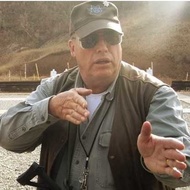26 Feb 19
Persistent Gun Myths:
“… an eternal ‘song-‘ waves within which reason has drowned.”
Friedrich Nietzsche
With the aid of left-leaning Hollywood dramatists, who have scant regard for the truth, an entire generation of Americans and Western Europeans have grown-up, believing preposterous myths they’ve seen depicted on the screen more times than anyone can count!
Indeed, I feel sorry for young people, who for the first time behold amorous friends of the opposite sex, who are unclad. When their naively false expectations, gleaned from years of looking at glamorous models depicted in skin magazines, are thus shattered asunder, I suspect many are never quite the same afterward!
Similarly, when viewers look in wonderment at Hollywood’s phoney rendition of “violence,” they are set-up for an extremely unpleasant, and dangerous, surprise when they encounter genuine violence!
As legitimate educators on this serious subject, my fellow instructors and I are routinely presented with the formidable task of helping our students know and understand the real truth, and thus be unburdened from a host of grievously unrealistic expectations.
Examples:
1) The “dramatic death sequence”
When a person is struck with a bullet (particularly a handgun bullet, even several), all kinds of behavioral changes can happen, and everything you can imagine probably has, at one time or another.
However, outcomes such as:
A) The person instantly exploding in a shower of sparks
B) The person hurled into the air (usually with a triple-gainer or two), or
C) The person clutching his chest and then dramatically, agonizingly lecturing the shooter on the true meaning of life for at least twenty minutes,
are all pretty unlikely, although shooting incidents are portrayed thusly, with nauseating frequency, in movies!
In reality, of all behavioral changes on the part of the shootee, you as the shooter may notice, the one most likely to occur is that the shootee will run away. That outcome happens more, by far, than any other!
Actually, after being struck with a bullet(s), the shootee is unlikely to “do” anything, for at least a second or two. As the shooter, you’ll thus have no way of knowing if you were successful or not, as you’re unlikely to be able to see entry-wounds, nor blood.
When he does run away ( a “good outcome,” by the way), he’ll likely display no discernible discomfort in the short term.
Of course, none of that is particularly “dramatic,” so it is shunned by TV dramatists.
You won’t sell corn flakes, nor acne medicine, by portraying people as they run away, now will you?
When trying to promote a particular caliber or brand of ammunition, you’ll hear misguided people say things like,
“A hit in his hand will tear his whole arm off”
Utter fantasy!
Those people need to spend more time at the range, and less in front of the TV!
2) Military snipers and head shots.
In domestic law enforcement, we often train our police snipers to shoot violent criminals in the braincase, because ranges are commonly short, and circumstances are usually such that we want to achieve “instant deanimation” of the felon.
No so with military sniping!
The job of the military sniper is to “manufacture casualties,” lots of them, preferably among the “most essential” of enemy combatants. Accordingly with military sniping, ranges are longer, but targets are bigger than is the case with police sniping.
A significant “hit” nearly anywhere on an enemy combatant’s body will produce a “casualty.” The person is no longer “effective,” and several other enemy combatants will have to stop what they’re otherwise doing in order to attend to him, and his wound(s).
That’s what military snipers do. They manufacture casualties. Instant death is not the goal!
However in movies, military snipers are constantly portrayed making unerring head-shots, always at ridiculous ranges, and their victims always die instantly.
Nothing could be further from the truth!
3) Riders getting shot off their horses
Our ancestors, when fighting horse-mounted Indians, enemy cavalrymen, or assorted other horse-mounted bad guys, almost never attempted to shoot the rider off his horse, as is falsely depicted in countless “westerns”
When defending against horse-mounted attackers, you shoot the horse!
The horse is a much bigger target than the rider, and when hit, the horse will probably fall, severely injuring the rider anyway!
In many cases, the rider is trapped under his fallen horse. With both horse and rider thus immobilized, follow-up shots are far more likely to be effective than when both horse and rider are moving!
But, Hollywood directors are frightened to death of being accused of injuring animals during filming, so they invariably show the stunt-man rider flying off his horse upon being shot, and the uninjured horse happily galloping away.
Again, utter nonsense!
The foregoing are examples of malicious the warping of reality, commonly committed by dramatists, that annoy me most.
Know and understand that nothing you see in dramatic presentations on TV, in movies, nor on the internet, while perhaps entertaining, has the slightest connection with reality, nor truth!
Expect it!
Don’t become a victim of it!
/John



